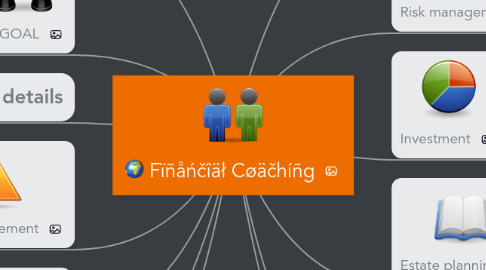
1. Saving
1.1. Education Planning
1.1.1. Age to Matriculation
1.1.2. Which University?
1.1.3. Current cost?
1.1.4. Inflation?
1.1.5. Other concerns
1.1.6. Funding Options
1.2. Pay yourself first
1.2.1. Save first?
1.2.2. Spend first?
2. GOAL
2.1. 3 steps
2.1.1. Where are you NOW?
2.1.2. Where are you heading to?
2.1.3. How to achieve it?
2.2. S.M.A.R.T.
2.2.1. Specific
2.2.2. Measurable
2.2.3. Achievable
2.2.4. Realistic
2.2.5. Time
2.3. financial objectives
2.3.1. Wealth maintenance
2.3.2. Wealth accumulation
2.3.3. Wealth protection
2.3.4. Wealth enhancment
2.3.5. Wealth distribution
3. For more details
3.1. Want More ideas?
3.2. Have a chat with Chew Hock Beng
3.3. +65 9389 7915
3.4. or eMail
4. Debt Management
4.1. Tenure
4.1.1. Medium
4.1.2. Short
4.1.3. Long
4.2. Interest rate
4.2.1. Fixed
4.2.2. Flexible
4.3. Repayment
4.3.1. Fixed
4.3.2. Extra
4.3.3. "Knock Off"
4.4. Economic
4.4.1. Rising
4.4.2. Sideway
4.4.3. Descending
5. Cash Flow
5.1. INflow
5.2. OUTflow
6. Net Worth
6.1. Assets
6.1.1. Liquid
6.1.2. Invested
6.1.3. Personal
6.2. Liabilities
6.2.1. Short
6.2.2. Long
7. Service modeling
7.1. Right Mindset
7.2. Service deliverables
7.3. Value proposition
7.4. Work system
7.4.1. Embrace technology
8. Financial Health Check!
8.1. Financial Ratio
8.1.1. Cash flow ratio
8.1.2. Balance sheet ratio
8.2. Budgetting
8.2.1. Set up spending priorities
8.2.2. Allocate your income
8.2.3. Evaluate what you spend
8.2.4. Pay yourself first
9. Risk management
9.1. Factors
9.1.1. Internal
9.1.1.1. Ability
9.1.1.2. Willingness
9.1.2. External
9.1.2.1. Frequency
9.1.2.2. Severity
9.2. Techniques
9.2.1. Avoid?
9.2.2. Reduce?
9.2.3. Accept?
9.2.4. Transfer?
10. Investment
10.1. Strategy
10.1.1. Tactical
10.1.2. Strategic
10.1.3. Constant-weighted
10.1.4. Integrated asset allocation
10.1.5. Dynamic
10.2. $1 to $2
10.2.1. Rule 72
10.3. The silence killer
10.3.1. Inflation
10.4. TÎMË
10.4.1. Tax
10.4.2. Inflation
10.4.3. Mistake
10.4.4. Emergency fund
10.5. Wealth Building
10.5.1. Investment
10.5.1.1. Saving
10.5.1.1.1. Income
10.6. Is an ÄRT
10.6.1. Amount
10.6.2. Risk-Reward
10.6.3. Time
10.7. Economic
10.7.1. Finanical market
10.7.1.1. Good
10.7.1.2. Stagnant
10.7.1.3. Bad
10.8. When to Exit
10.8.1. When original objective is met
10.8.2. When you need the money
10.8.3. Rebalance to meet the changing needs
10.8.4. When investment is a poor choice
10.8.5. Cut loss to prevent loss
10.8.6. When investment underperformed
10.8.7. When market condition change
10.8.8. When you are near your goal
11. Estate planning
11.1. Solution
11.1.1. Preserve
11.1.2. Protect
11.1.3. Perpetuate
11.2. Issues
11.2.1. Conflicts
11.2.2. Cost
11.2.3. Confusion
11.3. Challenges
11.3.1. Defer
11.3.2. Decrease
11.3.3. Dump
12. MIND.Desire.SELF.
12.1. Own it
12.1.1. Psychological
12.1.2. Emotional muscle
12.2. Plan it
12.2.1. LR Brainer
12.2.2. Visionary
12.3. Do it
12.3.1. Finanical muslce
12.4. Tools
12.4.1. DISC Profile
12.4.2. TQ
